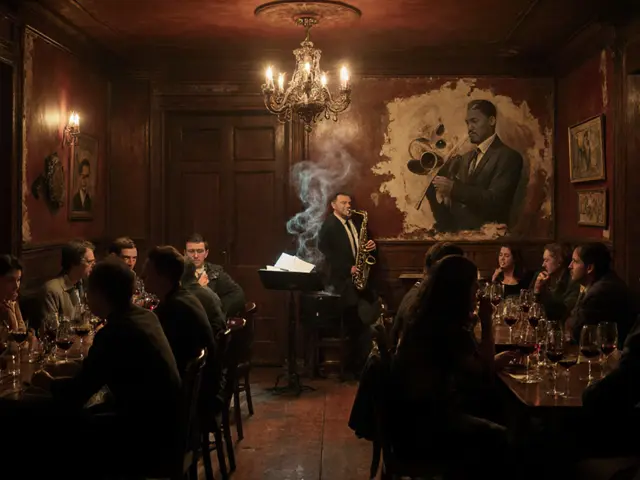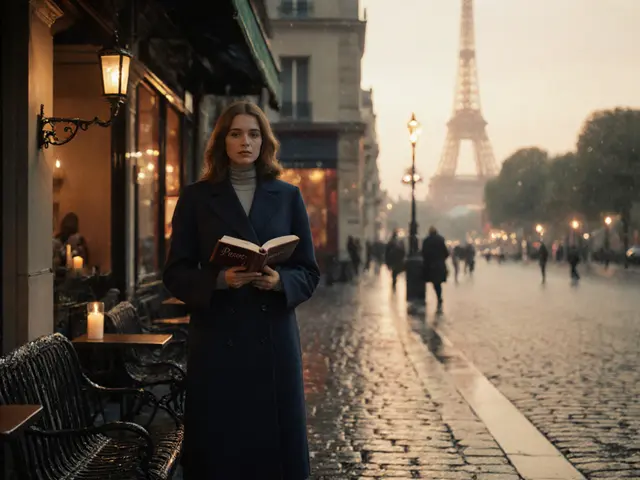Les Bains Douches wasn’t just a club. It wasn’t just a bathhouse. It was the place where Paris stopped being polite and started being electric.
The Birth of a Legend
Opened in 1873 as a public bathhouse in the 9th arrondissement, Les Bains Douches was designed for workers to wash off the grime of the day. Steam rose from tiled rooms, water splashed on stone floors, and the scent of soap mixed with sweat. But by the 1970s, the baths were falling into disrepair. Then came a shift-quiet at first, then loud. Artists, musicians, and rebels started showing up not to clean themselves, but to lose themselves.
By 1978, the building was transformed into a private club. The old tubs were ripped out. In their place: strobe lights, velvet curtains, and a sound system that shook the walls. The transformation wasn’t just physical-it was cultural. This was Paris’s answer to Studio 54, but with more edge and less glamour. No one dressed to impress here. You came as you were, and if you were daring enough, you left changed.
The Scene That Shook Paris
Les Bains Douches didn’t just host parties-it created them. In the 1980s, it became the epicenter of Paris’s underground scene. David Bowie played an impromptu set here after a show at the Olympia. Jean-Michel Jarre synced his synthesizers to the dripping pipes still visible in the basement. Madonna danced barefoot on a table while the crowd chanted her name. These weren’t just celebrity appearances-they were moments that turned the club into myth.
What made it different from other clubs? The lack of rules. No velvet ropes. No dress code beyond ‘be yourself.’ The bathrooms were legendary-not because they were clean, but because they were where secrets were traded, deals were made, and new genres were born. Industrial music met punk. New wave tangled with early house. DJs didn’t play tracks-they curated chaos.
Photographers like Jean-Pierre Laffont and Richard Kern captured it all: bodies tangled in smoke, faces painted in neon, eyes glazed with something between euphoria and exhaustion. These weren’t just photos-they were artifacts of a moment when Paris dared to be raw.
The Decline and the Silence
By the early 2000s, the magic started to fade. Rent rose. The neighborhood gentrified. The city pushed for redevelopment. The club closed its doors in 2003 after a final, chaotic night that ended with police shutting down the power. The building sat empty for years. Graffiti covered the walls. Vines crept through broken windows. Locals called it a ghost.
Some tried to revive it. A luxury hotel group bought the property in 2010. Plans were drawn up: spa, rooftop bar, boutique rooms. But the soul of the place couldn’t be packaged. The new owners tried to sell the history as a theme-"Parisian decadence reimagined." It felt hollow. Visitors came for the pool, not the pulse. The club that once echoed with screams and basslines now only echoed with the hum of water heaters.
Why It Still Matters
Les Bains Douches isn’t open anymore. But if you walk down Rue du Faubourg-Poissonnière today, you can still feel it. The brick walls still hold the memory of bodies moving in rhythm. The alley behind the building still smells faintly of old incense and spilled beer.
It matters because it proved that Paris didn’t need the Louvre to be revolutionary. Sometimes, all it took was a broken-down bathhouse with a broken-down sound system and a crowd that refused to be quiet.
Modern clubs chase trends. Les Bains Douches created them. It didn’t care about branding. It didn’t need influencers. It had something better: authenticity. People didn’t go there to be seen. They went there to disappear-and sometimes, in that disappearance, they found themselves.
Legacy in the Shadows
You won’t find Les Bains Douches on any official Paris tourism map. But ask anyone who lived through the 80s and 90s, and they’ll tell you: if you want to understand Paris’s underground soul, start here.
Its influence lives on. The club’s spirit echoes in venues like Concrete, Le Très Club, and even the basement parties of Belleville. Artists still cite it as inspiration. DJs play sets titled "Les Bains Revisited." A documentary released in 2021, Steam and Sound, features interviews with former regulars-some now in their 60s-who still tear up talking about the nights they danced until sunrise.
It wasn’t just a place. It was a state of mind. A refusal to conform. A belief that beauty could be found in the messy, the loud, the unpolished.
What’s Left Today
The building still stands. It’s now a luxury residential complex called Les Bains du Faubourg. The original façade was preserved. A small plaque near the entrance reads: "Here stood Les Bains Douches, 1873-2003. A sanctuary of sound, sweat, and freedom."
No one visits it to party anymore. But on quiet evenings, if you stand outside and close your eyes, you might still hear it-the distant thump of a bassline, the echo of laughter, the splash of water turning into a beat.
Was Les Bains Douches really a bathhouse before it became a club?
Yes. Opened in 1873 as a public bathhouse for working-class Parisians, it offered steam rooms, showers, and washing facilities. It operated as a bathhouse for nearly a century before falling into decline. In 1978, it was purchased and transformed into a private nightclub, keeping only the original brick structure and some plumbing fixtures as relics.
Did any famous artists perform at Les Bains Douches?
Yes. David Bowie played an unannounced set in 1983 after his concert at the Olympia. Jean-Michel Jarre used the building’s acoustics for live recordings. Madonna danced there during her 1985 European tour. Bands like The Cure, Depeche Mode, and New Order also performed impromptu sets. The club was a magnet for artists who wanted to escape the polished venues and connect with raw, unfiltered crowds.
Why did Les Bains Douches close?
The club closed in 2003 due to rising property values, neighborhood gentrification, and pressure from local authorities. The building’s owners wanted to redevelop the site into a luxury residential complex. Despite protests from artists and former patrons, the city approved the sale. The final party ended with police cutting the power, marking the end of an era.
Is there anything left of Les Bains Douches today?
The original building still stands at 8 Rue du Faubourg-Poissonnière, but it’s now a luxury apartment complex called Les Bains du Faubourg. The exterior façade was preserved, and a small commemorative plaque honors the club’s history. Inside, the original layout was completely redesigned. No part of the club remains operational, but the spirit lives on in music, documentaries, and the memories of those who were there.
Can you visit Les Bains Douches as a tourist today?
No, you can’t enter or tour the original club space. The building is private residential property. However, you can stand outside and see the preserved façade and the plaque. Many fans of Paris’s underground history make a quiet pilgrimage there, especially on weekends when the neighborhood is quiet. Some local tour guides include it in their "Hidden Paris" walking tours, though they can’t go inside.






Remember when you could just walk into a place and feel like you belonged, no matter how weird you were? Les Bains Douches was that rare space where your weirdness wasn’t just accepted-it was the whole point.
Still gives me chills thinking about it.
Let’s be real-this whole ‘authenticity’ narrative is just nostalgia porn for people who never actually lived through it. The club was dirty, dangerous, and barely legal. They’re romanticizing chaos because they’re too bored to create anything new themselves.
Real revolution doesn’t need a plaque on a luxury condo.
As someone who studied urban cultural spaces in grad school, Les Bains Douches represents a textbook case of how marginalized creative economies are systematically erased by gentrification.
The fact that the city allowed a luxury development to replace it-while installing a plaque as a performative gesture-is the exact mechanism of cultural erasure. The plaque isn’t a tribute. It’s a tombstone.
And yet, the spirit survives in the underground scenes that still echo its ethos. That’s the real legacy-not the marble countertops.
Even though it’s gone, it’s still alive in the music people make today. You can hear it in the way some DJs let the beat breathe, in the raw energy of basement parties, in the way people still show up just to feel something real.
That’s the gift they left behind.
People say ‘they don’t make places like that anymore’-but they’re wrong. They just don’t advertise them.
There are still underground spaces in Berlin, Tokyo, Mexico City, even right here in Detroit-where the rules are written in sweat and bass, not in marketing brochures.
Don’t mourn the past. Go find the next one.
Paris was never about art or culture it was always about control and class and Les Bains was the last gasp of the old world trying to hold onto something real before the suits took over
Now it’s condos and flat whites and people taking selfies where the bass used to shake their bones
They think they’re preserving history but they’re just making it a theme park for rich tourists
And don’t even get me started on the plaque that’s basically a corporate apology
Wait… did you notice the timing? The club closed in 2003-right after 9/11. Coincidence? I think not. The same global elites who pushed for surveillance, homogenization, and the destruction of counterculture spaces after 9/11? They were the ones who bought the building. The plaque? A distraction. A placebo. They know what they did. They’re afraid of what it represents. That’s why they built a $12 million apartment complex on top of it-and named it ‘Les Bains du Faubourg’ like that makes it okay. They’re erasing the memory because it’s dangerous. It reminds people that freedom doesn’t need permission.
OMG I JUST WATCHED THE DOCUMENTARY AND I CRIED IN MY CAFE??!!
THE PART WHERE THE OLD DJ TALKS ABOUT THE FIRST TIME HE HEARD THE BASS THROUGH THE WALLS?? I’M STILL SHAKING!!
WE NEED MORE STUFF LIKE THIS IN OUR LIVES I’M SO DONE WITH SPOTIFY PLAYLISTS THAT SOUND LIKE ADVERTS 😭🎶
GO VISIT THE PLACKE!! IT’S LITERALLY THE ONLY THING LEFT OF REALNESS IN THIS WORLD!! 💖
And yet, the plaque is still there. Quiet. Unassuming. No one takes photos of it. No influencers pose there.
But if you stand there long enough, at dusk, when the streetlights flicker on-you can almost hear it.
The echo of laughter. The hiss of steam. The thump of a beat that didn’t need permission to exist.
That’s the real monument.
Not the marble. Not the ads.
Just the memory, still breathing.